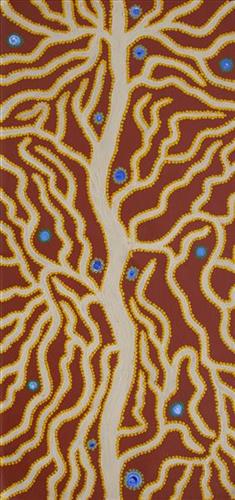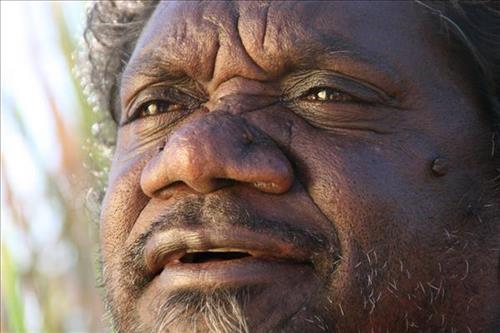111582091905
Yaralalu
“Yaralalu, north of Karlamilyi River (Rudall River) in Karlamilyi claypan Country. There’s a series of claypans in that Country. After it’s rained they all get filled up. It’s a camping area for Warnman people. They used to get water there and also from the Karlamilyi area. There’s sand dunes that run from the East to the West and stop at the river’s edge on each side. There’s a series of big claypans and small claypans. The river was created by the Jila Kujarra (Two Snakes) as they journeyed northeast to Nyayartakujarra (Lake Dora).”
– Desmond Taylor
Yaralalu is one of several fresh water sources located along the Karlamilyi River. This pool is located at the northeaster end of the river, just west of Nyayartakujarra (Lake Dora) and Punmu Aboriginal community. Many walyji (white gum) trees surround the site.
In his account of Yaralalu, Desmond describes the way that claypans such as this are seasonally filled by rains during the wantajarra (cool, wet season). During the pujiman (traditional, desert dwelling) era, it was at such times that areas around claypans were used as camping grounds. During the pujiman period, Martu would traverse very large distances annually in small family groups, moving seasonally from water source to water source, and hunting and gathering bush tucker as they went. At this time knowledge of water sources was critical for survival, and today Martu Country is still defined in terms of the location and type of water. Each of the hundreds of claypans, rockholes, waterholes, soaks and springs found in the Martu desert homelands is known by name, location, quality and seasonal availability through real life experience and the recounting of Jukurrpa (Dreaming) narratives.
Also described by Desmond is the formation of the Karlamilyi River and its surrounds by the travels of the ancestral beings, Jila Kujarra (Two Snakes). Jila Kujarra is one of the key Jukurrpa narratives for the Martu. Though the story belongs to Warnman people, it is shared across the Western Desert with several other language groups. The narrative centres on the travels of two snakes as they are pursued by the Niminjarra, spiritual ancestors of the Warnman people.




